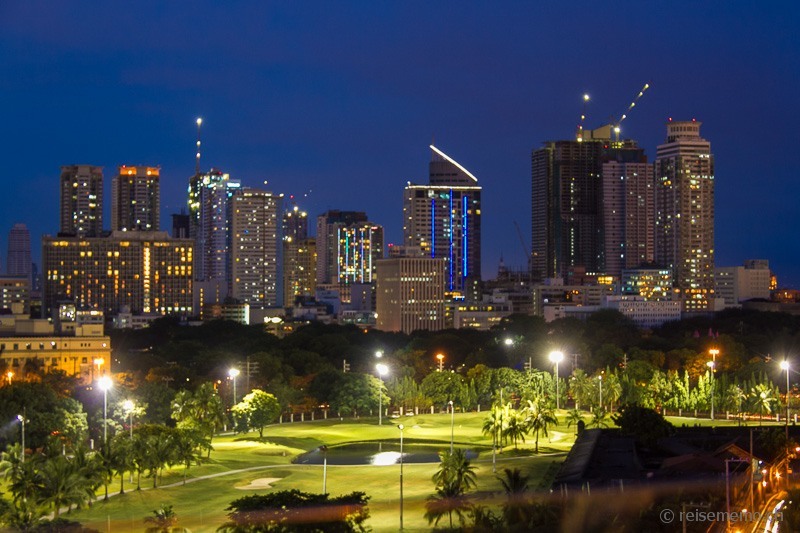The Philippine nation spreads over 7,107 islands. Depending on the tides… On being invited by tourasia, the Asia tour organizer, and Singapore Airlines, we set out to explore this Southeast Asian archipelago.
We didn’t make it to 7,000 islands, but we touched on one here and there. But let’s start from the beginning…
The most direct way from Zurich to Manila is by Singapore Airlines. Many tourists continue right on from here, because the mega metropolis of 15 million inhabitants doesn’t exactly radiate its charms right up front. But, as always, it pays to take a closer look…
If you insist on classic elegance and extensive infrastructure, you will do well lodging in the Fairmont Makati. They have giant rooms and you will truly not want for anything!
If you prefer a boutique hotel instead, take a closer look at the Bayleaf Intramuros. Its design and the only roof terrace in Manila argue strongly for it…

But, yes, it’s also true that Manila has Southeast Asia’s largest slum. The rich live isolated behind walls in their exclusive “Golden Ghetto” residential areas.
In the evenings, there are all kinds of goings on: probably ever since Spanish colonial times, the inhabitants of Manila (Manilans or Manileños) pull noisy all-nighters. You get to experience their proverbial friendliness quite quickly. You feel WARMLY welcomed everywhere you go; their big smiles really do come across as genuine. An example that quite a few tourist regions could learn from…
As for the traffic, I did not think Manila was all that bad. It must be said, however, that we were mainly moving around during off-hours. During rush hour, it can take several hours to go long distance. Since there is no subway, the legendary jeepneys bear the brunt of the traffic.
These US army jeep conversions were inherited from the American protectorate: They drive them everywhere in the country and on the island in stretch, half-stretch and any number of other versions: jeep in front, bus in the back is the operative concept .
[slickr-flickr search=sets set=”72157633600706303″ type=”gallery”]
Manila’s old town
Manila possesses structures not typically found in Asia, holdovers from the Spanish colonial period such as fortresses and churches, and they are therefore often referred to as Spanish. In general, here they speak an intriguing mix of Filipino, English and a few scraps of Spanish. A simple “derecho” in any event will hail a jeepney driver and tell him to drive straight on.
Evocatively, the old town behind the ancient ramparts is called “Intramuros“. The massive stone walls once served as the main line of defense against invaders from the seaward side.
Flight from Manila to Bacolod on the island of Negros
We had landed at Manila’s Ninoy Aquino International Airport . But for the onward journey, our flight left from Manila’s Centennial Airport. And I believe there is also a third airport. The traveler is therefore well advised to check not just if it is the correct terminal but if it is the right airport first. And allow sufficient extra time to get to the airport, because the traffic can always still jam up…
From Manila, our tourasia round trip took us to Visayas, a central group of islands, where we explored the islands of Negros, Bohol and Cebu and some of their neighboring islands. A 75 minute flight took us first to Bacolod on Negros Island.
This area rich in sugar cane is famous for its brown muscovado sugar and the Hawaiian-Philippine Company that produces it. “Hawaiian,” because at some point they discovered that it was not necessary to ship the sugar cane to Hawaii for processing but could instead import Hawaiian workers… old-style globalization, in a sense.
These days, sugar cane production has fallen behind production in other parts of the world, for lack of efficient industrialization on Negros. They would much rather offer the local families “sufficient manual labor jobs”.
How well the sugar barons must have fared, however, can be seen from the example of a typical mansion in Talisay. The elegant wooden mansion has all imaginable conveniences, and on the walls hang pictures of the prudent widow of the master of the house in the company of the-then President of the Philippines…
You were admitted to this part of the living quarters only if you were important enough.
Wooden facades provides good ventilation against the oppressive, humid heat. The walls are made of translucent shells and make the rooms brighter even with the sun blinds closed.
[slickr-flickr search=sets set=”72157633746615666″ type=”gallery”]
More to follow in the second part of this series of travel articles To Sipalay.
Many thanks to tourasia and Singapore Airlines!
Sincere thanks to Stephan Roemer with the Asia specialist tourasia for the invitation to this inspiring tour of the Philippines that the German-speaking, local tour director Jerry organized perfectly!
Also, a big thanks to Nina Eberth with Singapore Airlines for the generous flight arrangements!
And last but not least, we thank Susanne Schmitt with Primus Communications PR agency for putting us in touch with tourasia.